Last Chance to Catch NYC's Holiday Notalgia Train
We met the voices of the NYC subway on our nostalgia ride this weekend!


“For Benjamin, as for Baudelaire, the way into memory is through those ‘things that have gone out of fashion,’ which were once, when they first appeared, considered as the height of novelty, until fashion, like the weather, changed”¦” — Peter Wollen [1]
Val d’Europe, located next to Euro Disney in Marne-la-Vallée, was designed with the predeterminate purpose of transforming architectural stereotype into a saleable commodity, within the guise of a utopian residential community. In marketing documents by Euro Disney Associés SCA, specific key terms–future, optimistic, inspire, hope, dreams–feature repeatedly. The corporation boldly claims that since Val d’Europe’s history is “a clean slate, the future is in the hands of the town’s pioneers and, as a result, is somewhat more optimistic. Indeed, and perhaps to a greater degree than elsewhere, hope drives the town’s residents and entrepreneurs.” [2] Ironically, the architecture of Val d’Europe is anything but a clean slate, apart from the recent age of the construction. As an architecture of mimicry, Val d’Europe engenders various destabilizing disconnectivities–between form and function, exterior and interior, and time and location–all in the service of creating a culture of consumption.
The Val d’Europe shopping mall is the iconic embodiment of Disney’s design and business principles. With 100,000 m2 of retail space, the consumer is “enveloped, yet entertained”[3] by the visual fantasy and spectacle. In The Experience Economy, Joseph Pine and James H. Gilmore write, “Every business is a stage, therefore work is theater.” Val d’Europe was unveiled the same year that The Experience Economy was published by Harvard Business School, reflecting an observable shift towards a corporate-controlled planning of retail to create experiential spaces for the consumer–the Disneyification of shopping.
The architecture of the Val d’Europe shopping mall evokes not only nostalgia for an historical object but also references a specific period in French history: the XIX-ciécle (19th century)–a time of innovation, industry and the emergence of the mass consumer culture. The semiotics conveyed by the architectural elements in the mall intimate luxury, but not one of excess. This is a shopping experience for a targeted customer–the aspirational, working family. The mall retailers are predominantly family-oriented stores or fashion-forward discount brands. In an essay about Elle Magazine, Barthes suggests that the disconnect between architectural referent and the social class of the user is a deliberate gesture “to present to its vast public which (market-research tells us), is working class, the very dream”¦a fairy land reality.”[4] In fact, the term “aspirational” was coined by retailers to describe the desire for upwards mobility displayed by consumers through purchasing.
However, rather than conceptualizing the global (Disney) as an inexorable force imposing dominant cultural forms on the local (consumers/residents) without recourse, we see a dynamic, dialogic interaction–a hybrid intersection of local-global processes, in which the local also appropriates those dominant cultural forms. In other words, they are willing consumers who demand more opportunities to purchase through their behavior. As of 2005, La Vallée Village, the outlet adjacent to the shopping mall, was already operational and an additional 16,000 m2 of retail space was under development.[5] The irony of Val d’Europe is that the references to bygone architectural innovations inhibit any glimpse towards the future–the mall becomes a hollow shell with only referents to what were once functional elements.
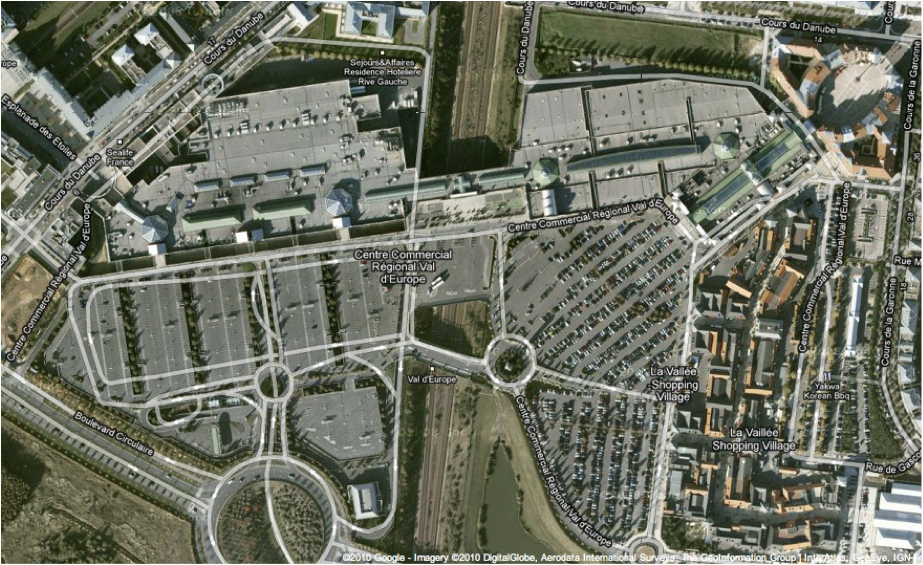
The floor plan at Val d’Europe completely subverts the crucifix foor plan trend of the first shopping malls which provided ease of circulation for the automobile and allocated the majority of parking in proximity to the anchor tenants, usually department stores. At Val d’Europe there is no major “anchor tenant” in the traditional sense, except for Auchan, a large supermarket submerged onto the lower level. The shopping mall is a straight promenade punctuated by circular pavilions for public space. The entrances to the mall are located at either end of the mall or at the pavilions. In accordance with the Val d’Europe planning principles as a walking city, automobile parking is relegated to the inside of the L-shape, hidden from view from the residential and pedestrian areas to the east and west.
But more than just a spatial subversion of traditional suburban mall planning, the design simultaneously refers to the French historical past through architectural details and the creation of spectacle-based public spaces. The promenade of successive corridors increase in visual drama and spectacle, culminating at the pinnacle of the mall: the food court.
In the Val d’Europe shopping mall, the public spaces take the form of circular pavilions located along the linear corridor of the mall. The shopper must thus traverse these spaces to continue shopping or to exit. Moreover, these spaces are not static but are theatrical sets for the display of spectacle. By naming of one of the thoroughfares within the shopping mall as “Le Promenade,” the nomenclature linguistically forms the link between programmatic intention and architecture.
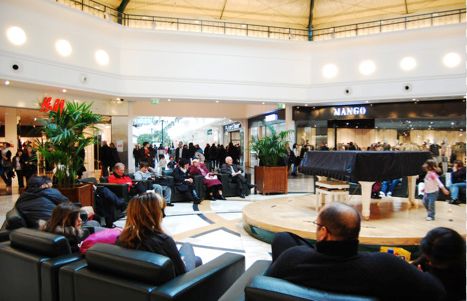
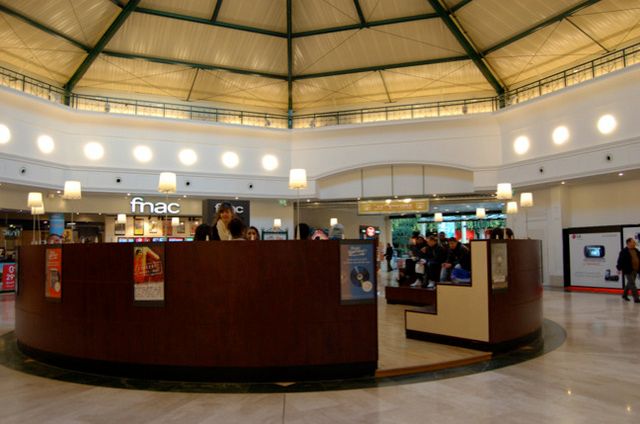
Walter Benjamin associates shopping with the circus, contending that in the nineteenth century, “consumers beg[a]n to consider themselves a mass. Hence, the circus-like and theatrical element of commerce is quite extraordinarily heightened.” [6] The idea of spectacle culminates in Les Terrasses food court with the impressive glass and iron ceiling, a clear imitation of the height and grandeur of the Grand Palais. Barthes writes that “what makes the circus or arena what they are is not the sky”¦it is the drenching and vertical quality of the flood of light.” [7]
Each successive corridor between Les Balcons des Halles and Les Terrasses becomes increasingly wider and well-lit. Indeed, in the Les Terrasses food court, natural light is one of the important contributors to the theatricality of the space. In a way, the length of Les Terrasses food court functions as a long stage, a microcosm of the greater promenade within the shopping mall.
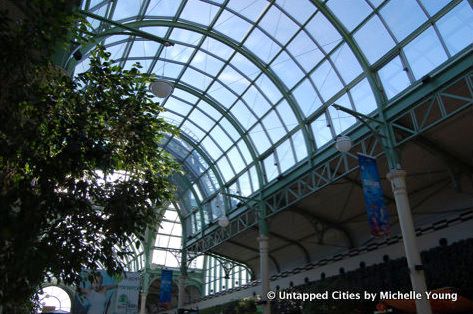
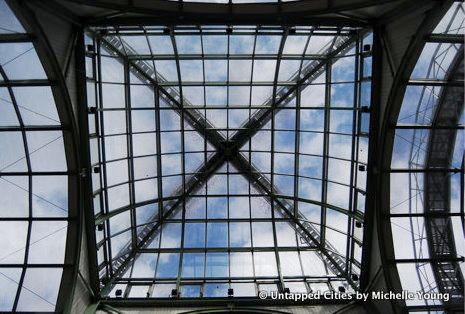
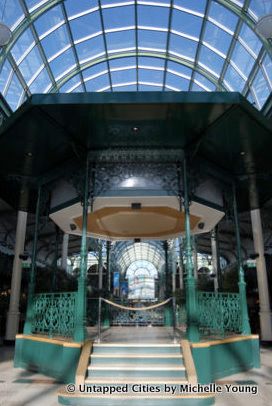
On one end of the food court is a carousel, similar to those at the Hà´tel de Ville, Republique, Montmartre and other areas of Paris. What is notable about this carousel is the patina of age superimposed onto the structure and the inclusion of non-functional details to create a sense of authenticity. The diamond-patterned metalwork on the columns is painted on and the depth of the detail is intimated through shadowing. In reality, the surface of the column is completely even. The paintings in the medallions are made to look like nineteenth-century art, surrounded by old and copper “metalwork” which is in actuality only gilded paint. Slender spotlights hover above the paintings, which is unnecessary given that Les Terrasses is illuminated via natural sunlight. Similarly, the circus-like row of light bulbs is also illuminated during daytime, functioning as detail rather than functional element. The metalwork on the top of the structure is painted and in this instance, the paint imitates rusted metal. This superficial detail is ironic given the indoor location of the carousel, but in line with the semiotics of spectacle throughout the mall.
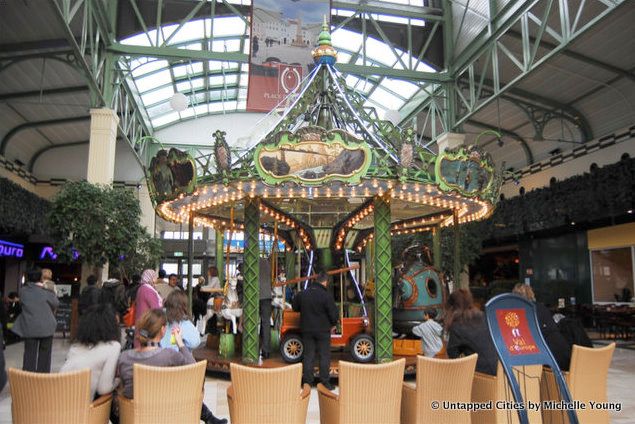
“In the course of flânerie, far-off times and places interpenetrate the landscape and the present moment.”[8]
– Walter Benjamin, “The Flâneur,” The Arcades Project

Benjamin’s statement about the anachronistic milieu of the nineteenth-century flâneur remains prescient in relation to the architecture of the Val d’Europe shopping mall in the twenty-first century. Similarly, the architecture of Val d’Europe carries with it the label of “French-ness” for a precise recreation of nineteenth-century architecture, inclusive of function, would partially negate the basic purpose of Val d’Europe, which is consumption. Thus, each successive space in the Val d’Europe shopping mall is subject to an increasing hybridization of architectural influences.
Les Balcons des Halles
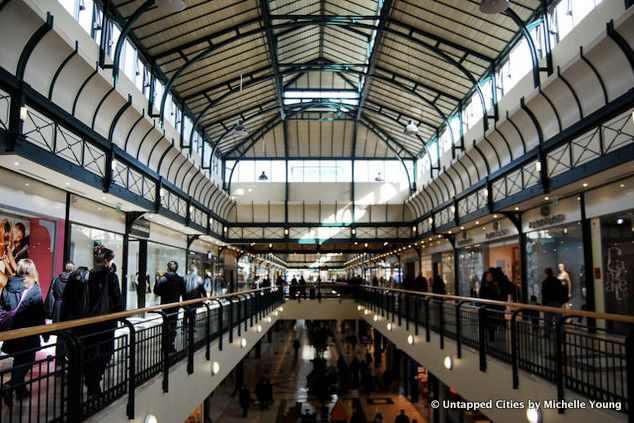
This two-floor hall combines elements of many nineteenth century buildings, but is not a direct imitation of any in particular. Because of its size, the architecture has the feeling of an indoor marketplace or bazaar (particularly appropriate for the Auchan located on the lower level), and is likely inspired partially by Les Halles. The bi-level construction with balconies is reminiscent of nineteenth-century Parisian department stores, such as Galleries Lafeyette, where the shopper can look across and downwards at the scene.
Les Passages Parisiens
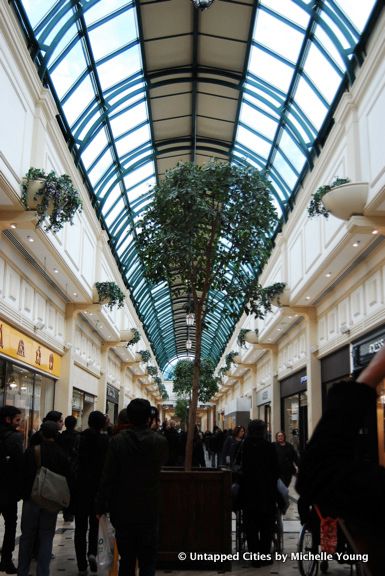
The name of this corridor gives away its architectural inspiration. Les Passages Parisiens is clearly in homage to the Parisian passage in detail and construction. First, it is the narrowest of the corridors in the Val d’Europe shopping mall. Its narrowness is accentuated via the addition of a curved glass roof that further emphasizes verticality over horizontality. The perspectival nature of the corridor is exaggerated via repetition of columns, the additional emphasis on the columns via large floral capitals, the linearity of the floor vegetation, and the geometric reiteration of the moldings.
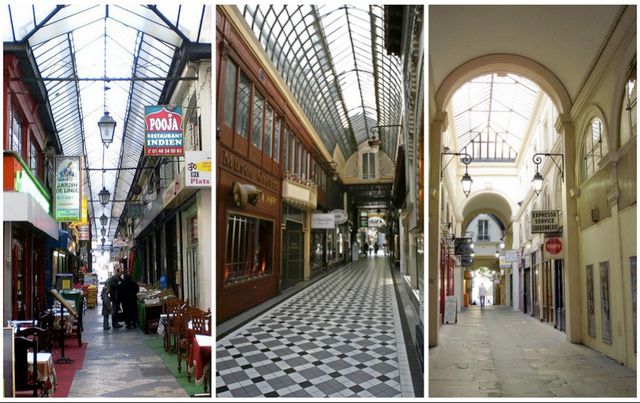
As expected with the Disneyification of architecture, the passage is both a hybrid and a simplification of the original sources. The lamp fixtures and the location of the lighting are similar to the treatment of lighting in the Passage Brady, where the fixtures hang from the ceiling in the center of the passage. The engaged column and the half-crescent window are borrowed from the Passage Vendome. Furthermore, the ceiling curvature and the diamond-patterned floor tiling are reminiscent of the Passage Jouffroy, but the facades are more reminiscent of the Passage des Panoramas or the Passage Vendome, where the plasterwork facades are equally dominant with the glass/ironwork. In some instances, the facades of the Parisian passage seem to have been collaged together over time, and in other locations, the facades are uniform and predesigned. The design of Parisian passages range between emphasizing perspective and highlighting the facades. Les Passages Parisiens in Val d’Europe attempts to do both.
La Promenade
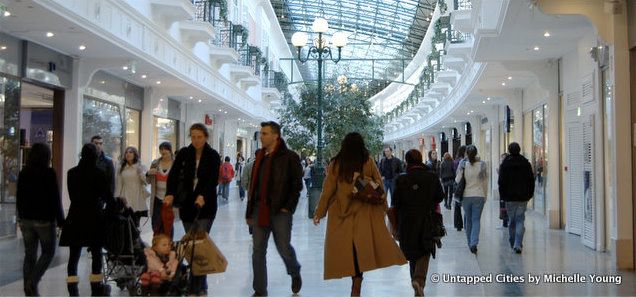
This corridor attempts to merge Parisian architectural details with the leisurely boardwalks of Nice and southern France. The reference to southern France is implied both visually and linguistically via the name, “La Promenade.” In Nice, the seaside walkway is officially named the Promenade des Anglais but is popularly referred to as La Promenade or La Prom for short. The word promenade is strongly connected to leisurely activity in Paris as well. The architecture of La Promenade is clearly intended to suggest an outdoor space, but recreated indoors. The ceiling is the only non-symmetrical ceiling in the Val d’Europe shopping mall, suggesting that aestheticism has been subordinated to the overarching message of exteriority. In order to create the feeling of being outdoors, the ceiling has been angled upwards to maximize the amount of natural light in the corridor. A crescent faà§ade psychologically increases the amount of interior space while signifying an outdoor location. Freestanding lamp posts are the prominent “street” furniture in La Promenade and are significantly out of proportion in contrast to the scale of the other furniture in the corridor, such as the free standing trees and the signage.
![]](https://www.untappedcities.com/content/images/wp-content/uploads/2011/09/valdeurope-19.jpg)
La Promenade is the only corridor to blatantly feature the exterior details of residential architecture. The colored pastel paint is a direct reference to the brightly colored facades in Mediterranean port cities such as Nice and Capri. The window shutters not only reference Mediterranean architecture, but also attempts to replicate authenticity via variation of type. In addition, the shutters are displayed in a range of positions from open to ajar to closed to suggest authenticity in usage. Variation in type and usage attempt to convey a false sense of spontaneity in a very controlled design.
Despite an overarching intent to mimic Mediterranean architecture, once again the hybridization is apparent: Mediterranean colors and architectural details, Parisian lamppost and a name shared by both locations.
Les Terrasses
As mentioned previously, Les Terrasses food court is architecturally en homage to the Grand Palais and Les Halles. The steel is of a lighter green shade than what is used in the rest of the shopping mall, suggesting that the construction is a mimicry of the Grand Palais. The amount of natural light, the height of the interior and the size of the glass panes are also similar to construction in the Grand Palais.
On the other hand, Les Terrasses is more similar in function to Les Halles, which was the traditional central market in Paris. The produce stalls were arranged along the walls of each hall (and down the middle), creating strong vertical lines towards the vanishing point. Similarly, the food establishments in Les Terrasses are all located along the wall of the space, leaving the center for leisure and theater–a true fusion of the exhibitionary nature of the Grand Palais with the commercial function of Les Halles.
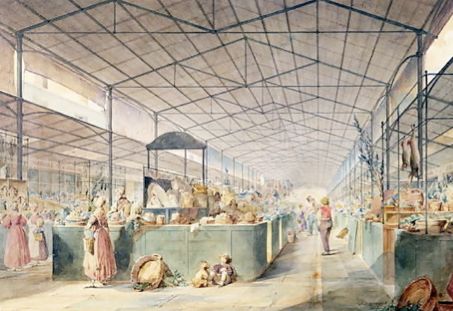
Dreams figure prominently in the writings of Barthes, Benjamin, Boyer and even Euro Disney. In the Val d’Europe marketing documents, it is proclaimed that the philosophy behind the town is “to create a place where individuals can make their dreams and desires a reality,”[9] while simultaneously building a town from scratch. The conflation of spaces creates a new architectural experience, perhaps not authentic but over time will become no less “real” for its consumers. Barthes would find the semiotic language of the shopping mall unclear and a manifestation of the duplicitous nature of the bourgeoisie, who seek only the material. This new reality is disconnected from not only history but from the intellectual and the visceral: the only two pure forms a sign should take, according to Barthes.[10] As such, the shopping mall will be frozen in space and time, because bourgeois ideology “continuously transforms the products of history into types. [The bourgeois] cannot rest until it has obscured the ceaseless making of the world, fixated this world into an object which can be forever possessed, catalogued its riches, embalmed it, and injected into reality some purifying essence which will stop its transformation.”[11] Finally, he connects such rigidity to the desire to consume. He proclaims, “For the very end of myths is to immobilize the world: they must suggest and mimic a universal order which has fixated once and for all the hierarchy of possessions.”[12]
An analysis of the Val d’Europe shopping mall suggests that this stagnation has already taken place. From the self-proclaimed intent by the developers that the architecture should “aspire to a certain timelessness,” to the irony that timelessness in this instance means a mimicry and degradation of the original, and finally to the countless tourists that traverse the space each day who may not be fully aware of the historical references, the only clear message signified by the interior is one of consumption.
[1] Wollen, Peter.” ¨”The Concept of Fashion in The Arcades Project.”” ¨Boundary 2. 30.1 (2003): 139.
[2] Val d’Europe Communications/Euro Disney Associés S.C.A., Embracing the 21
Century VD’E Val d’Europe. New Enterprise. New Society. New Ideas: 11.
[3] Boyer, M. Christine. “Invented Traditions and Cityscapes.” The City of Collective Memory: Its Historical Imagery and Architectural Entertainments

.Cambridge: MIT Press. (1996): 300.
[4] Barthes, Roland. Mythologies. New York: The Noonday Press. (1972): 78-79
[5] Val d’Europe Communications 21
[6] Benjamin 43
[7] Barthes 13
[8] Benjamin, Walter. The Arcades Project

. Cambridge: The Belknap Press of Harvard University. (1999): 432.
[9] Val d’Europe Communications/Euro Disney Associés S.C.A. 2
[10] Barthes 26
[11] Barthes 79
[12] Barthes 79
Subscribe to our newsletter